System Analysis and Design for the Gold-Cinema Case Study
VerifiedAdded on 2023/01/12
|10
|2315
|73
AI Summary
This assignment focuses on the system analysis and design for the Gold-Cinema case study. It covers the systems development life cycle, work breakdown structure, and use case diagram of the Gold-Cinema online system.
Contribute Materials
Your contribution can guide someone’s learning journey. Share your
documents today.
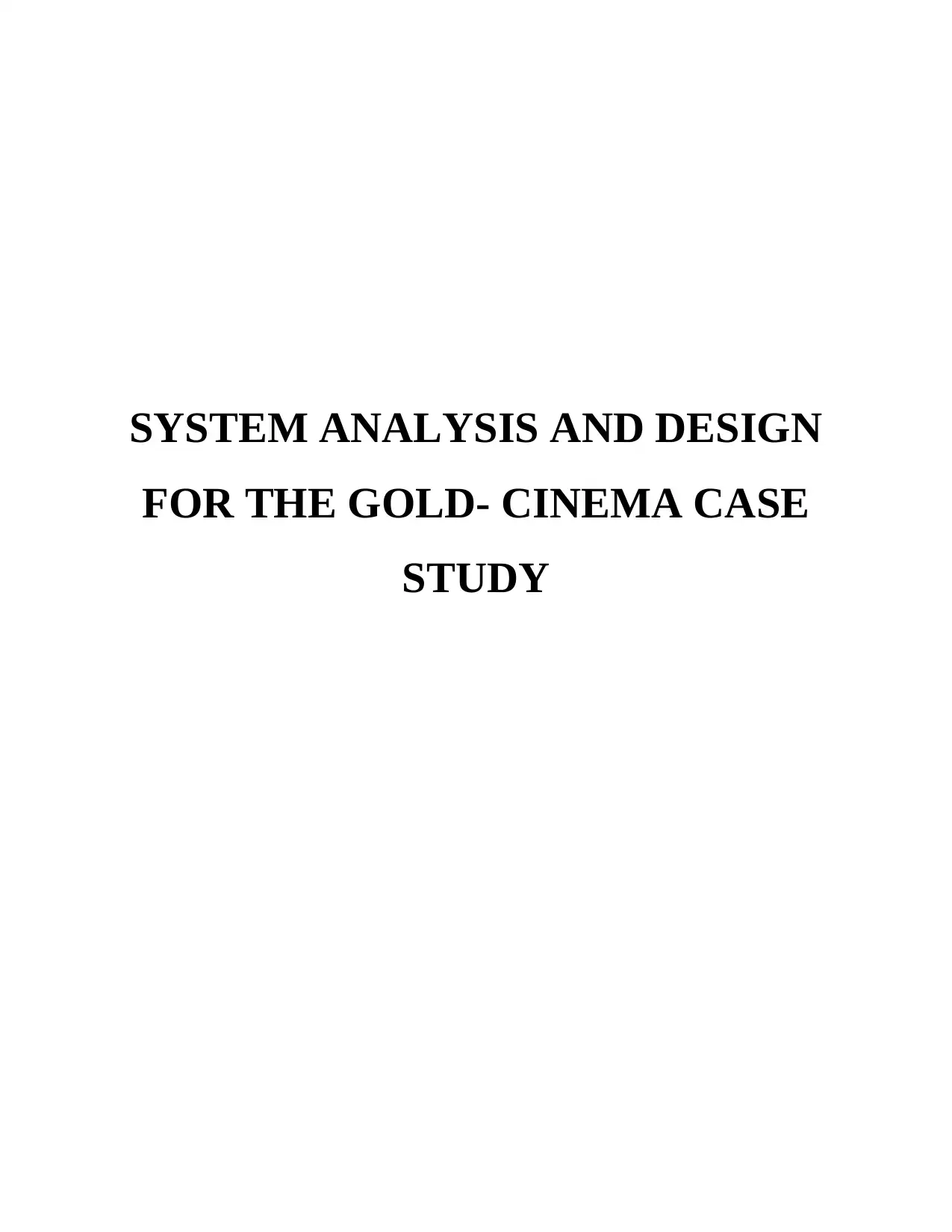
SYSTEM ANALYSIS AND DESIGN
FOR THE GOLD- CINEMA CASE
STUDY
FOR THE GOLD- CINEMA CASE
STUDY
Secure Best Marks with AI Grader
Need help grading? Try our AI Grader for instant feedback on your assignments.

TABLE OF CONTENTS
INTRODUCTION...........................................................................................................................2
MAIN BODY..................................................................................................................................2
Systems Development Life Cycle...............................................................................................2
Work Breakdown Structure.........................................................................................................4
use case diagram of GC System..................................................................................................5
CONCLUSION................................................................................................................................6
REREFENCES................................................................................................................................7
1
INTRODUCTION...........................................................................................................................2
MAIN BODY..................................................................................................................................2
Systems Development Life Cycle...............................................................................................2
Work Breakdown Structure.........................................................................................................4
use case diagram of GC System..................................................................................................5
CONCLUSION................................................................................................................................6
REREFENCES................................................................................................................................7
1

INTRODUCTION
System design and analysis can be defined as a kind of methodology that can be used for
developing information system of high quality that combines data, people, information
technology in order to support and fulfil business requirements (Putri, 2017). System analysis
and development is not only limited to IT systems but it can also be used for development of any
kind of computerized system. It is a simple technique which is used for development of
successful Information Technology projects. System analysis and design help professionals or
developers to get a clarity of the system which is required to be developed which further helps
them to develop an enhanced and appropriate system. This assignment will focus on a case study
of Gold Cinema who wants to develop an online system in order to track their customers, notify
them about upcoming events, identify customers who frequently uses Cinema, save details of
advisors who will be providing support to the customers. On the basis of this case study, this
assignment will lay emphasis on system development life cycle, work break down structure,
PERT/CPM chart explaining the early and late start for each task, return on investment and use
case diagram of the Gold Cinema online System.
MAIN BODY
Systems Development Life Cycle
A system can be defined as a set of interdependent and interacting components that forms an
integrated system. System development life cycle also known as SDLC can be defined as a
conceptual model which is mainly used in project management, This model helps in describing
stages that are involved in development of information system is developed from initial stage
where requirements of the system and feasibility study of the system is done to final testing and
maintenance stage ((Galin, 2018)(Hlaing and Ochimizu, 2018) Badawi and et al., 2019). SDLC
can be applied to both the kinds of system i.e. technical and non-technical system. SDLC is a
limited term that helps in explaining phases or stages through which development or creation of
software components is done for the creation of whole system. There are different kinds of
system and each system is different from others in terms of complexities, functionalities and
expected solution. Stages of system development life cycle helps in developing a system in such
a manner that all the risk associated with the system can be identified and requirements can be
fulfilled. There are six core processes of the SDLC required to be focused on for development of
the Gold cinema project. Six main phases of system development life cycle are as follows:
2
System design and analysis can be defined as a kind of methodology that can be used for
developing information system of high quality that combines data, people, information
technology in order to support and fulfil business requirements (Putri, 2017). System analysis
and development is not only limited to IT systems but it can also be used for development of any
kind of computerized system. It is a simple technique which is used for development of
successful Information Technology projects. System analysis and design help professionals or
developers to get a clarity of the system which is required to be developed which further helps
them to develop an enhanced and appropriate system. This assignment will focus on a case study
of Gold Cinema who wants to develop an online system in order to track their customers, notify
them about upcoming events, identify customers who frequently uses Cinema, save details of
advisors who will be providing support to the customers. On the basis of this case study, this
assignment will lay emphasis on system development life cycle, work break down structure,
PERT/CPM chart explaining the early and late start for each task, return on investment and use
case diagram of the Gold Cinema online System.
MAIN BODY
Systems Development Life Cycle
A system can be defined as a set of interdependent and interacting components that forms an
integrated system. System development life cycle also known as SDLC can be defined as a
conceptual model which is mainly used in project management, This model helps in describing
stages that are involved in development of information system is developed from initial stage
where requirements of the system and feasibility study of the system is done to final testing and
maintenance stage ((Galin, 2018)(Hlaing and Ochimizu, 2018) Badawi and et al., 2019). SDLC
can be applied to both the kinds of system i.e. technical and non-technical system. SDLC is a
limited term that helps in explaining phases or stages through which development or creation of
software components is done for the creation of whole system. There are different kinds of
system and each system is different from others in terms of complexities, functionalities and
expected solution. Stages of system development life cycle helps in developing a system in such
a manner that all the risk associated with the system can be identified and requirements can be
fulfilled. There are six core processes of the SDLC required to be focused on for development of
the Gold cinema project. Six main phases of system development life cycle are as follows:
2
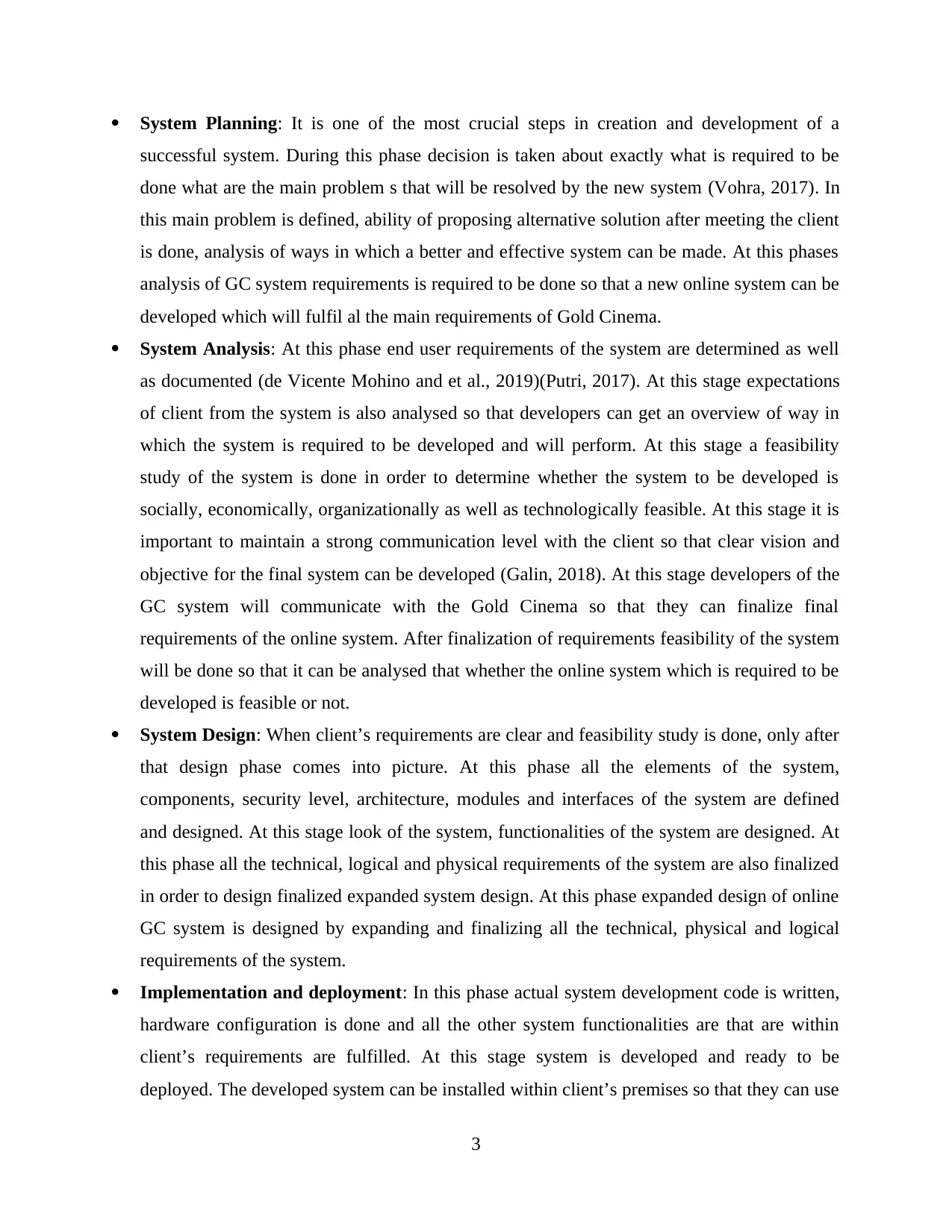
System Planning: It is one of the most crucial steps in creation and development of a
successful system. During this phase decision is taken about exactly what is required to be
done what are the main problem s that will be resolved by the new system (Vohra, 2017). In
this main problem is defined, ability of proposing alternative solution after meeting the client
is done, analysis of ways in which a better and effective system can be made. At this phases
analysis of GC system requirements is required to be done so that a new online system can be
developed which will fulfil al the main requirements of Gold Cinema.
System Analysis: At this phase end user requirements of the system are determined as well
as documented (de Vicente Mohino and et al., 2019)(Putri, 2017). At this stage expectations
of client from the system is also analysed so that developers can get an overview of way in
which the system is required to be developed and will perform. At this stage a feasibility
study of the system is done in order to determine whether the system to be developed is
socially, economically, organizationally as well as technologically feasible. At this stage it is
important to maintain a strong communication level with the client so that clear vision and
objective for the final system can be developed (Galin, 2018). At this stage developers of the
GC system will communicate with the Gold Cinema so that they can finalize final
requirements of the online system. After finalization of requirements feasibility of the system
will be done so that it can be analysed that whether the online system which is required to be
developed is feasible or not.
System Design: When client’s requirements are clear and feasibility study is done, only after
that design phase comes into picture. At this phase all the elements of the system,
components, security level, architecture, modules and interfaces of the system are defined
and designed. At this stage look of the system, functionalities of the system are designed. At
this phase all the technical, logical and physical requirements of the system are also finalized
in order to design finalized expanded system design. At this phase expanded design of online
GC system is designed by expanding and finalizing all the technical, physical and logical
requirements of the system.
Implementation and deployment: In this phase actual system development code is written,
hardware configuration is done and all the other system functionalities are that are within
client’s requirements are fulfilled. At this stage system is developed and ready to be
deployed. The developed system can be installed within client’s premises so that they can use
3
successful system. During this phase decision is taken about exactly what is required to be
done what are the main problem s that will be resolved by the new system (Vohra, 2017). In
this main problem is defined, ability of proposing alternative solution after meeting the client
is done, analysis of ways in which a better and effective system can be made. At this phases
analysis of GC system requirements is required to be done so that a new online system can be
developed which will fulfil al the main requirements of Gold Cinema.
System Analysis: At this phase end user requirements of the system are determined as well
as documented (de Vicente Mohino and et al., 2019)(Putri, 2017). At this stage expectations
of client from the system is also analysed so that developers can get an overview of way in
which the system is required to be developed and will perform. At this stage a feasibility
study of the system is done in order to determine whether the system to be developed is
socially, economically, organizationally as well as technologically feasible. At this stage it is
important to maintain a strong communication level with the client so that clear vision and
objective for the final system can be developed (Galin, 2018). At this stage developers of the
GC system will communicate with the Gold Cinema so that they can finalize final
requirements of the online system. After finalization of requirements feasibility of the system
will be done so that it can be analysed that whether the online system which is required to be
developed is feasible or not.
System Design: When client’s requirements are clear and feasibility study is done, only after
that design phase comes into picture. At this phase all the elements of the system,
components, security level, architecture, modules and interfaces of the system are defined
and designed. At this stage look of the system, functionalities of the system are designed. At
this phase all the technical, logical and physical requirements of the system are also finalized
in order to design finalized expanded system design. At this phase expanded design of online
GC system is designed by expanding and finalizing all the technical, physical and logical
requirements of the system.
Implementation and deployment: In this phase actual system development code is written,
hardware configuration is done and all the other system functionalities are that are within
client’s requirements are fulfilled. At this stage system is developed and ready to be
deployed. The developed system can be installed within client’s premises so that they can use
3
Secure Best Marks with AI Grader
Need help grading? Try our AI Grader for instant feedback on your assignments.
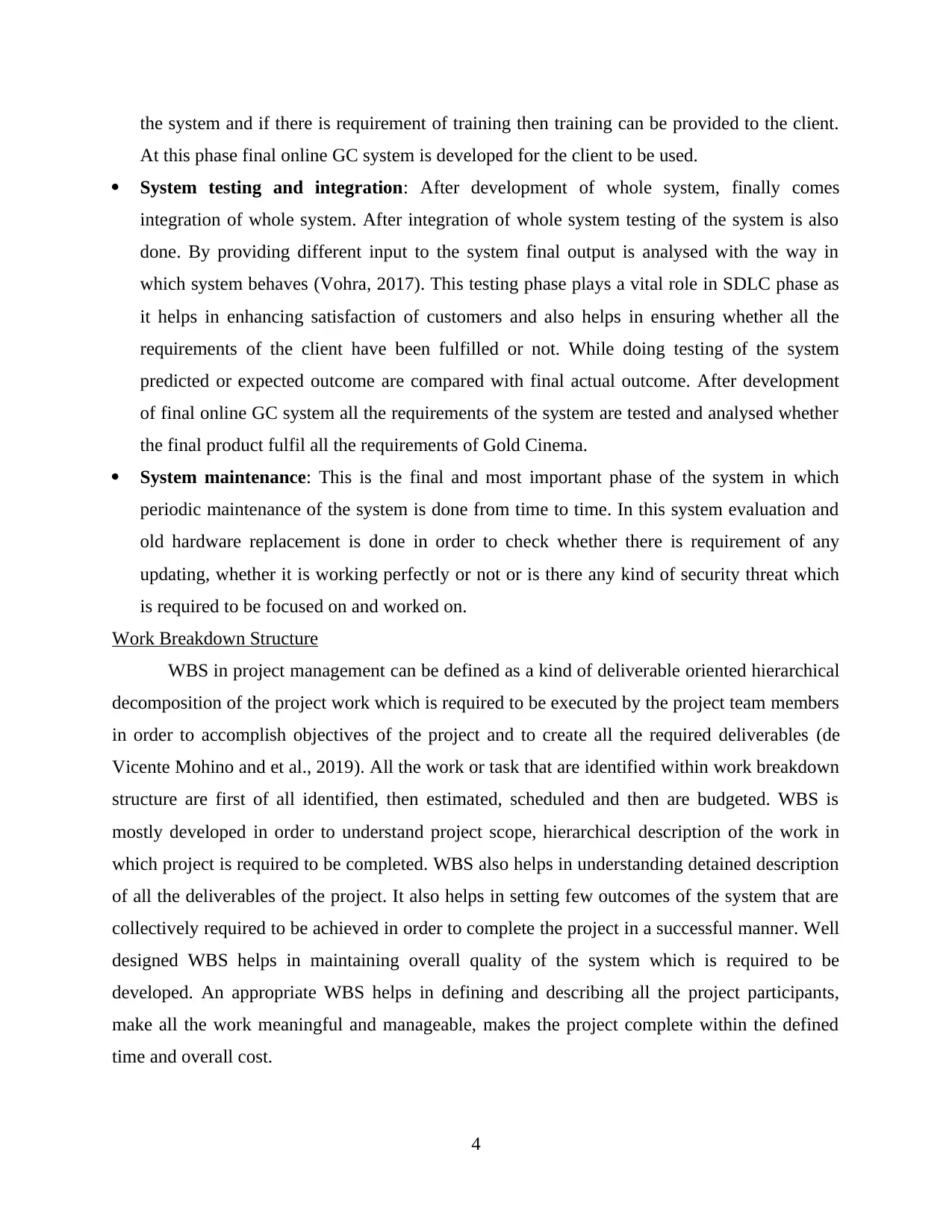
the system and if there is requirement of training then training can be provided to the client.
At this phase final online GC system is developed for the client to be used.
System testing and integration: After development of whole system, finally comes
integration of whole system. After integration of whole system testing of the system is also
done. By providing different input to the system final output is analysed with the way in
which system behaves (Vohra, 2017). This testing phase plays a vital role in SDLC phase as
it helps in enhancing satisfaction of customers and also helps in ensuring whether all the
requirements of the client have been fulfilled or not. While doing testing of the system
predicted or expected outcome are compared with final actual outcome. After development
of final online GC system all the requirements of the system are tested and analysed whether
the final product fulfil all the requirements of Gold Cinema.
System maintenance: This is the final and most important phase of the system in which
periodic maintenance of the system is done from time to time. In this system evaluation and
old hardware replacement is done in order to check whether there is requirement of any
updating, whether it is working perfectly or not or is there any kind of security threat which
is required to be focused on and worked on.
Work Breakdown Structure
WBS in project management can be defined as a kind of deliverable oriented hierarchical
decomposition of the project work which is required to be executed by the project team members
in order to accomplish objectives of the project and to create all the required deliverables (de
Vicente Mohino and et al., 2019). All the work or task that are identified within work breakdown
structure are first of all identified, then estimated, scheduled and then are budgeted. WBS is
mostly developed in order to understand project scope, hierarchical description of the work in
which project is required to be completed. WBS also helps in understanding detained description
of all the deliverables of the project. It also helps in setting few outcomes of the system that are
collectively required to be achieved in order to complete the project in a successful manner. Well
designed WBS helps in maintaining overall quality of the system which is required to be
developed. An appropriate WBS helps in defining and describing all the project participants,
make all the work meaningful and manageable, makes the project complete within the defined
time and overall cost.
4
At this phase final online GC system is developed for the client to be used.
System testing and integration: After development of whole system, finally comes
integration of whole system. After integration of whole system testing of the system is also
done. By providing different input to the system final output is analysed with the way in
which system behaves (Vohra, 2017). This testing phase plays a vital role in SDLC phase as
it helps in enhancing satisfaction of customers and also helps in ensuring whether all the
requirements of the client have been fulfilled or not. While doing testing of the system
predicted or expected outcome are compared with final actual outcome. After development
of final online GC system all the requirements of the system are tested and analysed whether
the final product fulfil all the requirements of Gold Cinema.
System maintenance: This is the final and most important phase of the system in which
periodic maintenance of the system is done from time to time. In this system evaluation and
old hardware replacement is done in order to check whether there is requirement of any
updating, whether it is working perfectly or not or is there any kind of security threat which
is required to be focused on and worked on.
Work Breakdown Structure
WBS in project management can be defined as a kind of deliverable oriented hierarchical
decomposition of the project work which is required to be executed by the project team members
in order to accomplish objectives of the project and to create all the required deliverables (de
Vicente Mohino and et al., 2019). All the work or task that are identified within work breakdown
structure are first of all identified, then estimated, scheduled and then are budgeted. WBS is
mostly developed in order to understand project scope, hierarchical description of the work in
which project is required to be completed. WBS also helps in understanding detained description
of all the deliverables of the project. It also helps in setting few outcomes of the system that are
collectively required to be achieved in order to complete the project in a successful manner. Well
designed WBS helps in maintaining overall quality of the system which is required to be
developed. An appropriate WBS helps in defining and describing all the project participants,
make all the work meaningful and manageable, makes the project complete within the defined
time and overall cost.
4

Work Breakdown Structure
4. Calculation of NPV, ROI and payback period
Net present value
Computation of NPV
Year
Cash
Benefits
Annual Expenses +
Development cost
Cash
inflows
PV factor
@ 10%
Discounted
cash
inflows
1 9000 3700 5300 0.909 4818.181
2 9000 3850 5150 0.826 4256
3 9000 3770 5230 0.751 3929
4 9000 3750 5250 0.683 3586
5 9000 3730 5270 0.621 3272
Total
discounted
cash inflow 19862
Initial
investment 15000
NPV (Total
discounted
cash inflows
- initial
investment) 4862
5
4. Calculation of NPV, ROI and payback period
Net present value
Computation of NPV
Year
Cash
Benefits
Annual Expenses +
Development cost
Cash
inflows
PV factor
@ 10%
Discounted
cash
inflows
1 9000 3700 5300 0.909 4818.181
2 9000 3850 5150 0.826 4256
3 9000 3770 5230 0.751 3929
4 9000 3750 5250 0.683 3586
5 9000 3730 5270 0.621 3272
Total
discounted
cash inflow 19862
Initial
investment 15000
NPV (Total
discounted
cash inflows
- initial
investment) 4862
5
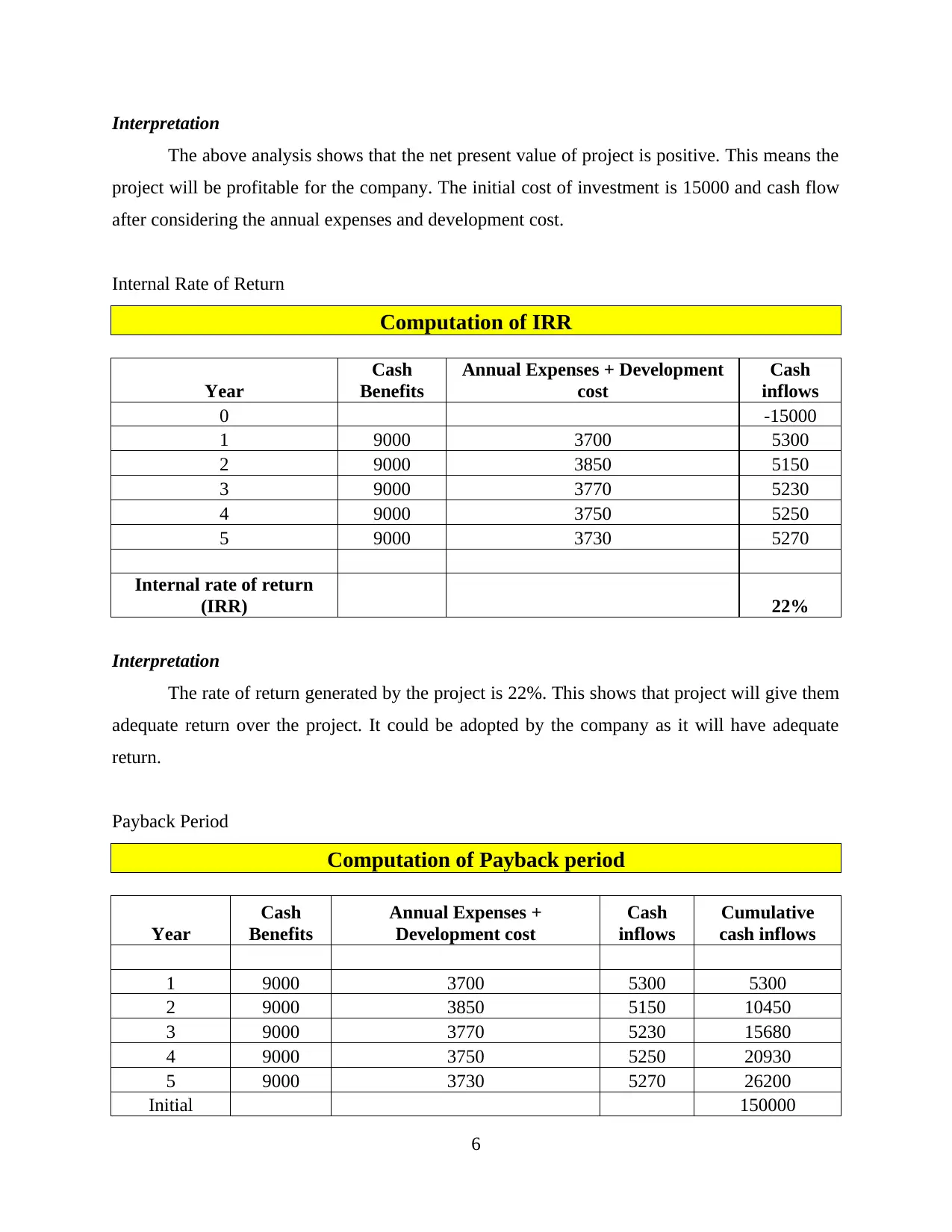
Interpretation
The above analysis shows that the net present value of project is positive. This means the
project will be profitable for the company. The initial cost of investment is 15000 and cash flow
after considering the annual expenses and development cost.
Internal Rate of Return
Computation of IRR
Year
Cash
Benefits
Annual Expenses + Development
cost
Cash
inflows
0 -15000
1 9000 3700 5300
2 9000 3850 5150
3 9000 3770 5230
4 9000 3750 5250
5 9000 3730 5270
Internal rate of return
(IRR) 22%
Interpretation
The rate of return generated by the project is 22%. This shows that project will give them
adequate return over the project. It could be adopted by the company as it will have adequate
return.
Payback Period
Computation of Payback period
Year
Cash
Benefits
Annual Expenses +
Development cost
Cash
inflows
Cumulative
cash inflows
1 9000 3700 5300 5300
2 9000 3850 5150 10450
3 9000 3770 5230 15680
4 9000 3750 5250 20930
5 9000 3730 5270 26200
Initial 150000
6
The above analysis shows that the net present value of project is positive. This means the
project will be profitable for the company. The initial cost of investment is 15000 and cash flow
after considering the annual expenses and development cost.
Internal Rate of Return
Computation of IRR
Year
Cash
Benefits
Annual Expenses + Development
cost
Cash
inflows
0 -15000
1 9000 3700 5300
2 9000 3850 5150
3 9000 3770 5230
4 9000 3750 5250
5 9000 3730 5270
Internal rate of return
(IRR) 22%
Interpretation
The rate of return generated by the project is 22%. This shows that project will give them
adequate return over the project. It could be adopted by the company as it will have adequate
return.
Payback Period
Computation of Payback period
Year
Cash
Benefits
Annual Expenses +
Development cost
Cash
inflows
Cumulative
cash inflows
1 9000 3700 5300 5300
2 9000 3850 5150 10450
3 9000 3770 5230 15680
4 9000 3750 5250 20930
5 9000 3730 5270 26200
Initial 150000
6
Paraphrase This Document
Need a fresh take? Get an instant paraphrase of this document with our AI Paraphraser
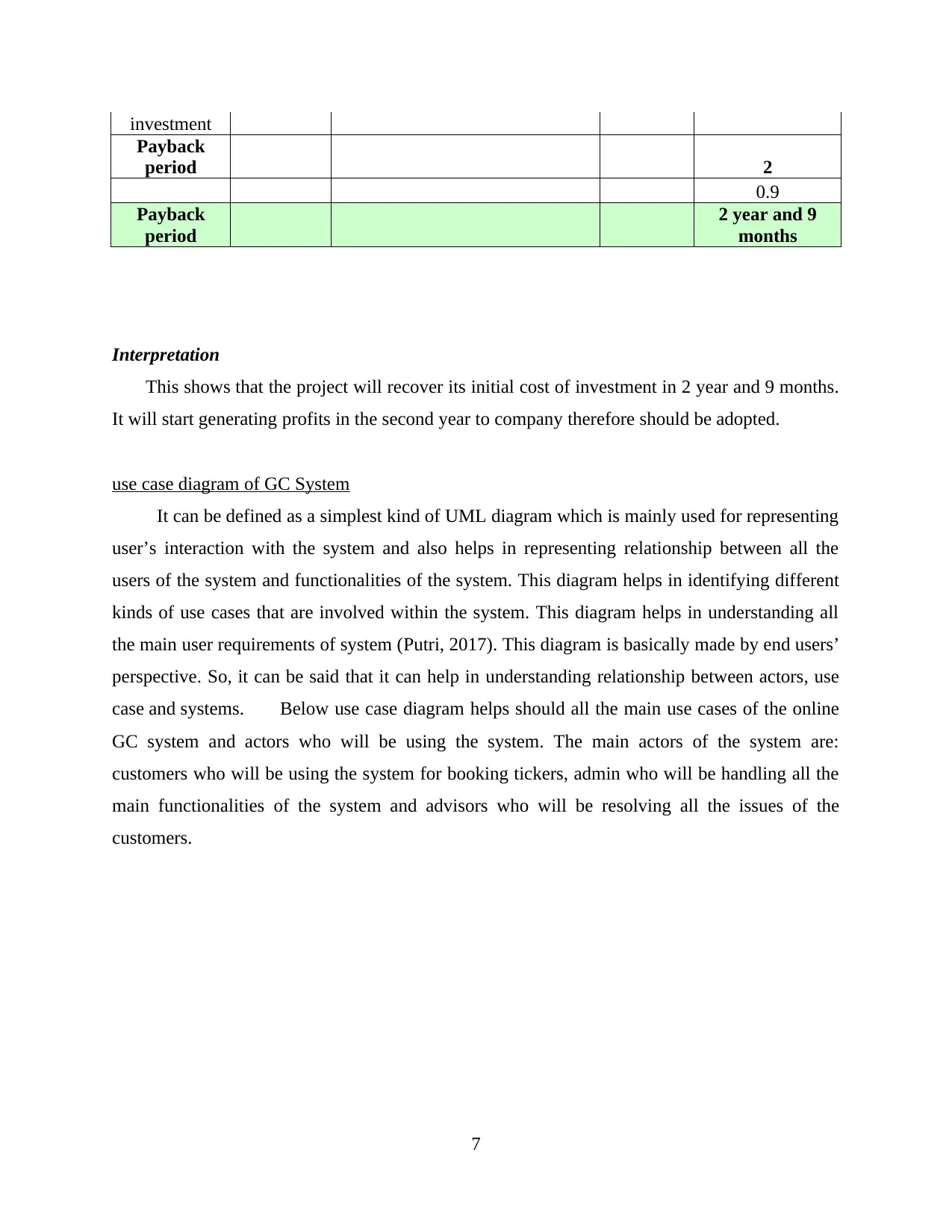
investment
Payback
period 2
0.9
Payback
period
2 year and 9
months
Interpretation
This shows that the project will recover its initial cost of investment in 2 year and 9 months.
It will start generating profits in the second year to company therefore should be adopted.
use case diagram of GC System
It can be defined as a simplest kind of UML diagram which is mainly used for representing
user’s interaction with the system and also helps in representing relationship between all the
users of the system and functionalities of the system. This diagram helps in identifying different
kinds of use cases that are involved within the system. This diagram helps in understanding all
the main user requirements of system (Putri, 2017). This diagram is basically made by end users’
perspective. So, it can be said that it can help in understanding relationship between actors, use
case and systems. Below use case diagram helps should all the main use cases of the online
GC system and actors who will be using the system. The main actors of the system are:
customers who will be using the system for booking tickers, admin who will be handling all the
main functionalities of the system and advisors who will be resolving all the issues of the
customers.
7
Payback
period 2
0.9
Payback
period
2 year and 9
months
Interpretation
This shows that the project will recover its initial cost of investment in 2 year and 9 months.
It will start generating profits in the second year to company therefore should be adopted.
use case diagram of GC System
It can be defined as a simplest kind of UML diagram which is mainly used for representing
user’s interaction with the system and also helps in representing relationship between all the
users of the system and functionalities of the system. This diagram helps in identifying different
kinds of use cases that are involved within the system. This diagram helps in understanding all
the main user requirements of system (Putri, 2017). This diagram is basically made by end users’
perspective. So, it can be said that it can help in understanding relationship between actors, use
case and systems. Below use case diagram helps should all the main use cases of the online
GC system and actors who will be using the system. The main actors of the system are:
customers who will be using the system for booking tickers, admin who will be handling all the
main functionalities of the system and advisors who will be resolving all the issues of the
customers.
7
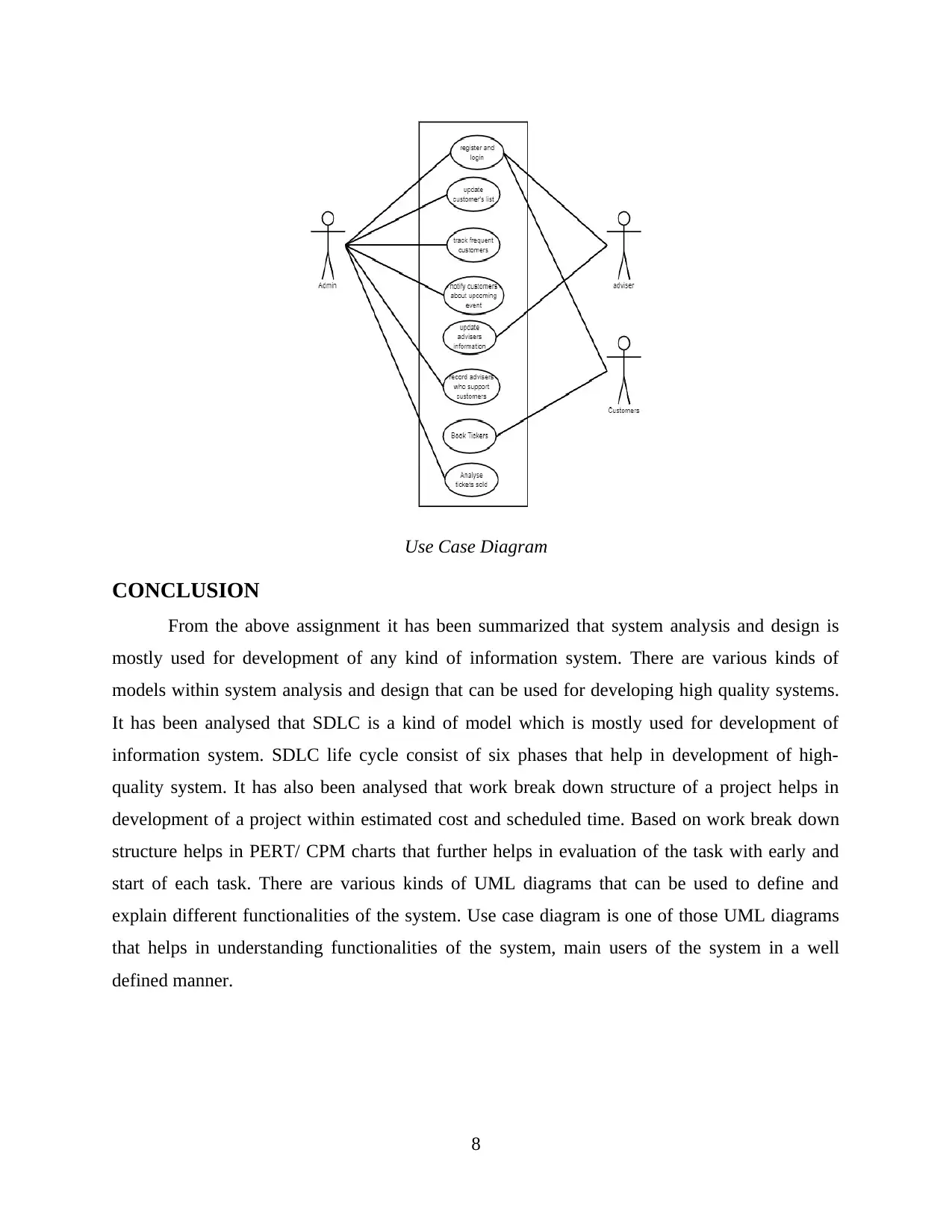
Use Case Diagram
CONCLUSION
From the above assignment it has been summarized that system analysis and design is
mostly used for development of any kind of information system. There are various kinds of
models within system analysis and design that can be used for developing high quality systems.
It has been analysed that SDLC is a kind of model which is mostly used for development of
information system. SDLC life cycle consist of six phases that help in development of high-
quality system. It has also been analysed that work break down structure of a project helps in
development of a project within estimated cost and scheduled time. Based on work break down
structure helps in PERT/ CPM charts that further helps in evaluation of the task with early and
start of each task. There are various kinds of UML diagrams that can be used to define and
explain different functionalities of the system. Use case diagram is one of those UML diagrams
that helps in understanding functionalities of the system, main users of the system in a well
defined manner.
8
CONCLUSION
From the above assignment it has been summarized that system analysis and design is
mostly used for development of any kind of information system. There are various kinds of
models within system analysis and design that can be used for developing high quality systems.
It has been analysed that SDLC is a kind of model which is mostly used for development of
information system. SDLC life cycle consist of six phases that help in development of high-
quality system. It has also been analysed that work break down structure of a project helps in
development of a project within estimated cost and scheduled time. Based on work break down
structure helps in PERT/ CPM charts that further helps in evaluation of the task with early and
start of each task. There are various kinds of UML diagrams that can be used to define and
explain different functionalities of the system. Use case diagram is one of those UML diagrams
that helps in understanding functionalities of the system, main users of the system in a well
defined manner.
8
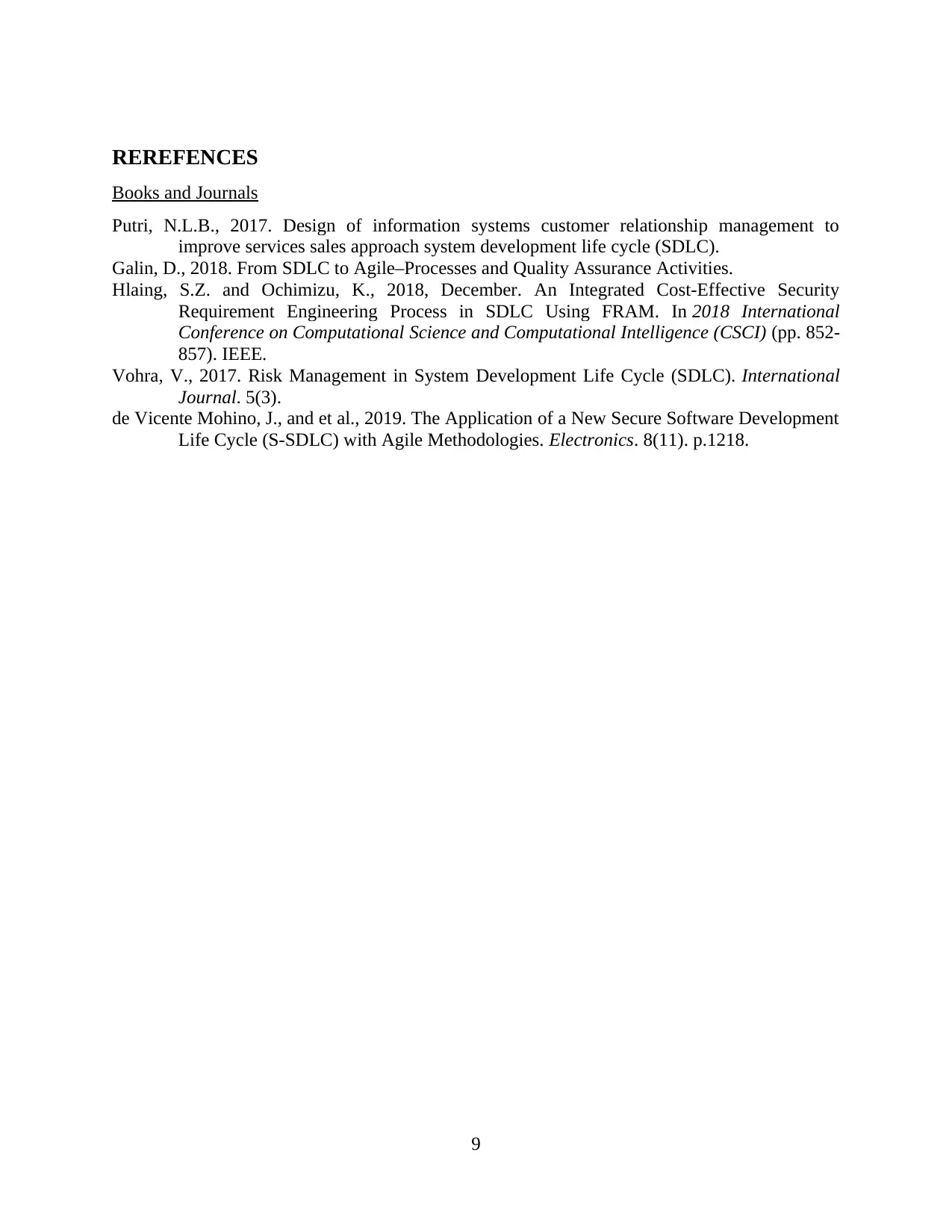
REREFENCES
Books and Journals
Putri, N.L.B., 2017. Design of information systems customer relationship management to
improve services sales approach system development life cycle (SDLC).
Galin, D., 2018. From SDLC to Agile–Processes and Quality Assurance Activities.
Hlaing, S.Z. and Ochimizu, K., 2018, December. An Integrated Cost-Effective Security
Requirement Engineering Process in SDLC Using FRAM. In 2018 International
Conference on Computational Science and Computational Intelligence (CSCI) (pp. 852-
857). IEEE.
Vohra, V., 2017. Risk Management in System Development Life Cycle (SDLC). International
Journal. 5(3).
de Vicente Mohino, J., and et al., 2019. The Application of a New Secure Software Development
Life Cycle (S-SDLC) with Agile Methodologies. Electronics. 8(11). p.1218.
9
Books and Journals
Putri, N.L.B., 2017. Design of information systems customer relationship management to
improve services sales approach system development life cycle (SDLC).
Galin, D., 2018. From SDLC to Agile–Processes and Quality Assurance Activities.
Hlaing, S.Z. and Ochimizu, K., 2018, December. An Integrated Cost-Effective Security
Requirement Engineering Process in SDLC Using FRAM. In 2018 International
Conference on Computational Science and Computational Intelligence (CSCI) (pp. 852-
857). IEEE.
Vohra, V., 2017. Risk Management in System Development Life Cycle (SDLC). International
Journal. 5(3).
de Vicente Mohino, J., and et al., 2019. The Application of a New Secure Software Development
Life Cycle (S-SDLC) with Agile Methodologies. Electronics. 8(11). p.1218.
9
1 out of 10
Related Documents
Your All-in-One AI-Powered Toolkit for Academic Success.
+13062052269
info@desklib.com
Available 24*7 on WhatsApp / Email
![[object Object]](/_next/static/media/star-bottom.7253800d.svg)
Unlock your academic potential
© 2024 | Zucol Services PVT LTD | All rights reserved.





